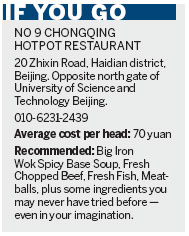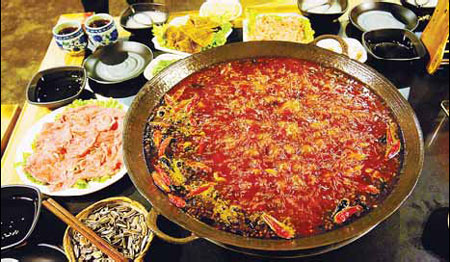Hot to trot, the secret simmer in Chongqing's pots
Updated: 2013-06-16 07:43
By Ye Jun(China Daily)
|
|||||||
|
The base soup recipe is each Chongqing hotpot restaurant's best-kept secret. Ye Jun / China Daily |

For gourmets, Chongqing-style hotpot is hugely tempting, though there are risks and inconveniences.
The minute you enter the door of No 9 Chongqing Hotpot Restaurant (or even from a distance) the aroma will assail you. Unlike Beijing-style hotpot, which uses broth, or sometimes clear water as a base soup, Chongqing hotpot is a lot more complicated.
Chefs spend hours frying and simmering the main ingredients - beef drippings, preserved chili, preserved ginger, soybean sauce, garlic, shallots and Sichuan pepper. There are as many as 15 ingredients, prepared in broth of beef and pork bones.
The base soup recipe is the best-kept secret in each Chongqing hotpot restaurant and the reason why the city's hotpots are legendary. Local residents laugh contemptuously when they talk about Beijing's hotpot tradition. Even so, there are at least two factors to consider before digging into that big iron bowl.
Can you stand the spiciness and numbness? The chili and Sichuan pepper are a major part of the pot's flavor. But some people just can't handle the overstimulation of their taste buds. Luckily many Sichuan restaurants, when they arrive in Beijing, tone down the heat and numbness to cater to local taste buds.
Another difficulty, for some, is the variety of ingredients available at a Chongqing hotpot feast. Chongqing people are famous epicureans who enjoy the taste and texture of a huge variety of food and worry little about which part of the animal it is.
Expats are likely to encounter ingredients they've never tried before at a Chongqing hotpot restaurant. Some of the best known include duck and goose intestines, duck blood pudding, bovine windpipe and tripe. These are processed, clean and offer great textures. Pork chitterlings are one of the tastiest dishes at such restaurants, while the more adventurous may order pig brain.
More "normal" ingredients are freshly cut mutton, beef, kelp, shrimp paste, starch noodles, bean curd, and a wide variety of mushrooms and vegetables. Fresh grass carp, loach, beef and pork meatballs are other signature ingredients.
The owners of No 9 Chongqing Hotpot Restaurant are a Beijinger and his wife from Chongqing. The eatery has the husband's parrots guarding the entrance and is decorated in the style of Chongqing's old streets.
For Chongqing and Sichuan people, eating hotpot has developed into a culture. Big iron woks provide a local ambience, although they also serve a white base soup in a stainless steel pot.
On a wall of No 9 Chongqing Hotpot is a notice describing how locals put the different ingredients into the pot. It is suggested people first put in meat, so that the soup can take on the flavor.
Then comes seafood and vegetables.
Put in blood pudding and starch noodles last because they can make the base soup sticky.
The guide also advises diners not to put too many things in at a time, because raw ingredients should not be mixed with prepared ingredients. Boil and eat as you go is the way to do it.
Light ingredients, such as tripe and stomach, are boiled for 10 seconds to keep its crisp texture. Big chunks of food, such as bean curd and fish, are boiled until they are soft.
The hustle and bustle of the Chongqing hotpot restaurant makes it a great place to get together with friends.
But there can be other risks. Be aware that the wok splashes easily. So, wear something that does not show spills, and be prepared to wear an apron over your clothes.
Some people get tummy upsets after a Chongqing hotpot because of the chili. Dong Hecheng, owner of No 9 Chongqing Hotpot Restaurant, claims that a spicy hotpot "cleans the bowels" and "expels toxins".
It is summer, but nevertheless Chongqing-style hotpots are rather popular at the moment in Beijing.
A good choice is Yang Family's Hotpot near Sanlitun.
An appearance by Chinese pop singer Faye Wong is said to have contributed to the restaurant's popularity. But most people who visit say good things about it, as does the long waiting line to get a seat.
A Chongqing gourmet based in Beijing, Huang Ke, founder of Salt Restaurant, is also opening a hotpot eatery soon, named Huang's Family Old Hotpot.
The restaurant will provide traditional Chongqing-style iron woks and bronze pots.
yejun@chinadaily.com.cn
(China Daily 06/16/2013 page14)
